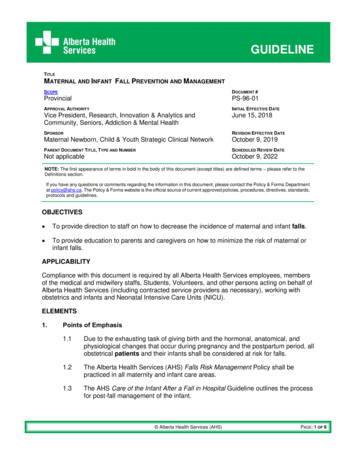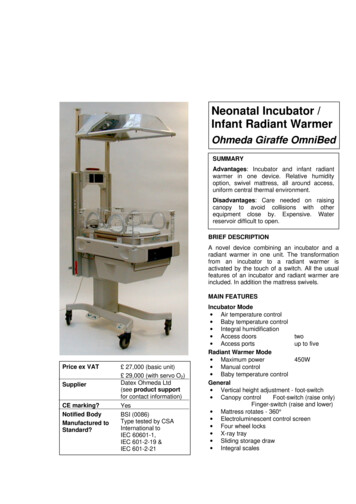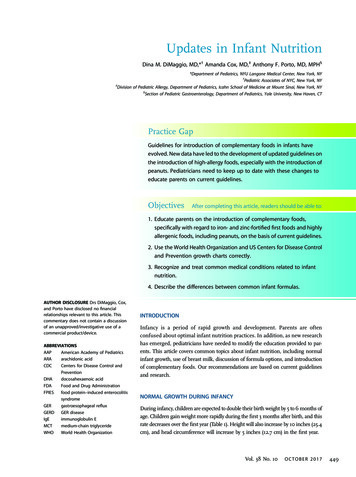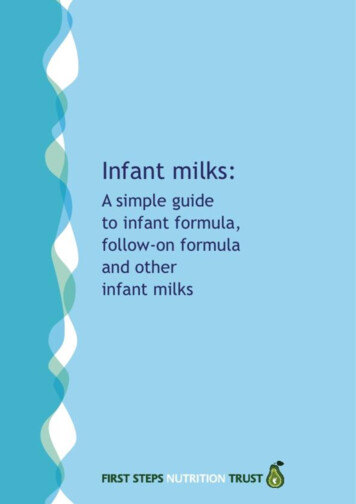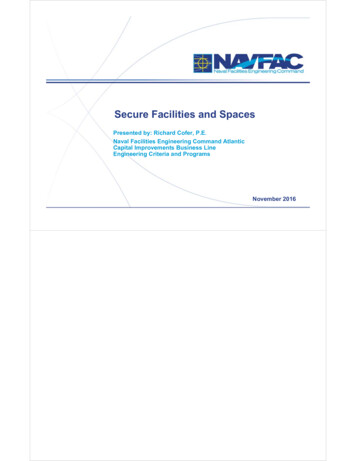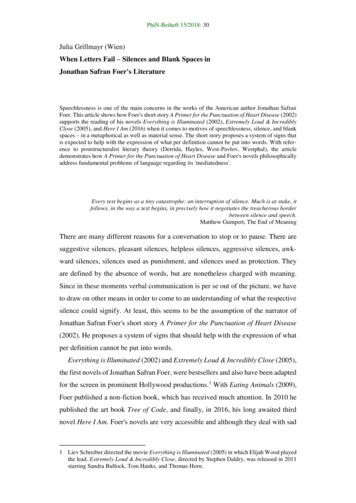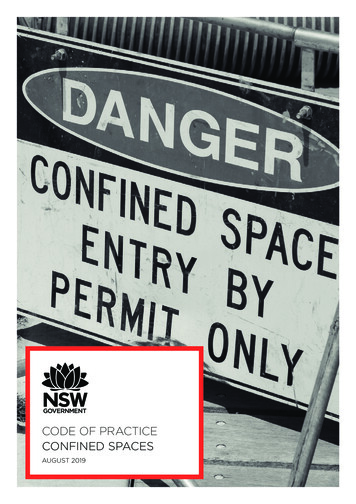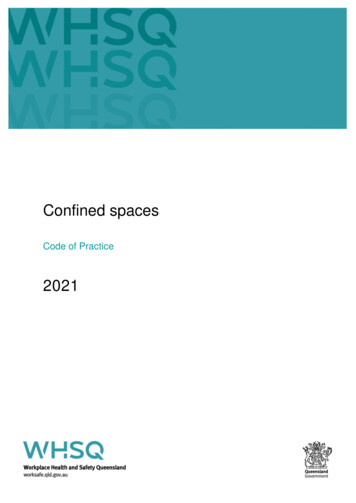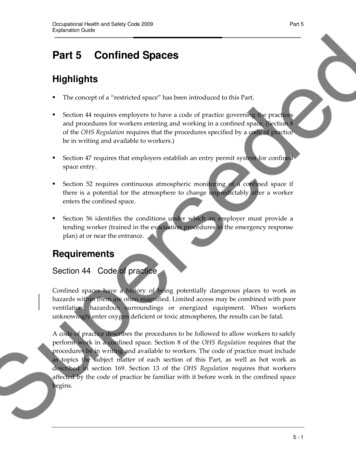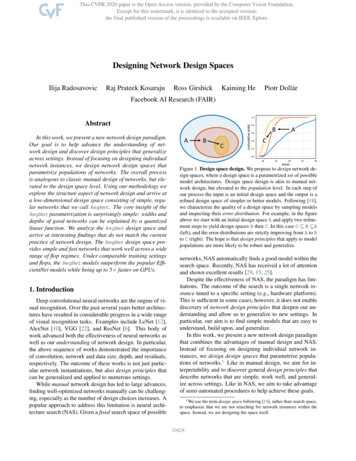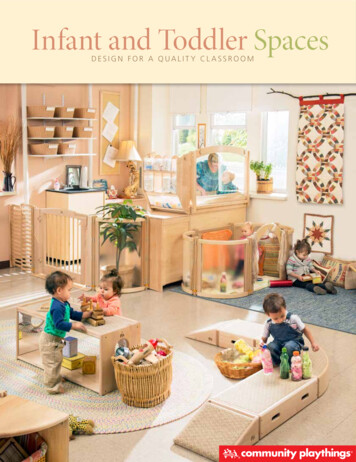
Transcription
Infant and Toddler SpacesDESIGN FOR A QUA L I T Y CL A SSROOM
Importance of the EnvironmentThe first months and years of achild’s life are the most formativein development of mind, body,and spirit. Sleep, emotionaland physical nourishment, andsensory stimulation are moreimportant in infancy than at anyother time. The most vital needfor these youngest children iswarm, nurturing care. We mustalso provide them with securesurroundings, and equipmentand playthings that meettheir needs and support theirindividual development.Quality childcare can be foundin all types of spaces. Still, weshould remember that thephysical environment, the spacearrangement, and the equipmentavailable will either promote“.the child needs a safe world where he is encouraged toor impede quality care. Bothventure, rewarded for venturing his own acts, and againstthe adults and the childrenshould find the environmentdistraction or premature interference.He needs a world richwelcoming and comfortable.with opportunities to see, hear, feel, touch, and move.A well organized, convenientlyThe child needs a setting where the world is literally at hisarranged, and appropriatelyequipped classroom givesJim Greenmanfingertips to safely explore and enjoy.”Caring Spaces,the caregiver more time forLearning Placesstimulating and supportiveinteractions with children.Special ThanksThis booklet is a collaboration between WestEd’s Programfor Infant/Toddler Care (PITC) and Community Playthings.We thank PITC for their research contribution. They havedeveloped the most widely used training system for infant andtoddler caregivers in the United States, and their team is atthe forefront of national efforts to improve infant/toddler care.More information is available at www.pitc.org.1
Brain DevelopmentThe first three years of achild’s life are critical for braindevelopment. After birth,brain cells establish trillions ofconnections. These connectingsynapses form the brain’s “maps”that govern thought, feelings,and behavior. Brain cells analyze,coordinate, and transmitinformation. The brain learnsand remembers throughout lifeby constantly changing thesenetworks as it receives input fromits environment.Although parents pass on avariety of characteristics to theirchildren through their genes, theenvironment plays a major rolein developing a child’s personalityby shaping the expression ofthose genes. External influences,from conception onward,offer the brain the intellectual,emotional, social, and physicalexperiences that make learningand memory possible.“ great strides have been made in understanding howvery young children learn and how their brains develop. Withour new knowledge comes new pressure to stimulate infants—in just the “right” ways—earlier and earlier. But childrenlearn more from the full complexity of their spontaneousinteractions with parents than from any pre-packaged program.”– T Berry Brazelton, MDAuthor and Pediatrician3
Stages of DevelopmentInfants experience three stages ofdevelopment. The caregiver-helpthat children require changes asthey progress through the stagesof infancy. It is important that thesurrounding environment supports both the growinginfants and the teachers who carefor them.Young Infants (0-8 months)In the first year of life childrenacquire a sense of trust—a feelingof safety and security. Basic trustcomes from warm and lovingrelationships with caregivers.When adults are responsive,predictable, and nurturing, infantsgain the self-esteem and courageneeded for further development.Young infants who feel safe startexploring the world. They needample opportunities to see, hear,feel, and touch. Movement iscrucial, as well as positive interactions between adult and child.Mobile Infants (6-18 months)Mobility opens up new horizonsfor infants. They begin to scoot andcrawl in their quest to understandand explore the world. Mobileinfants are fascinated withactivities and objects of daily lifeand will repeatedly open and close,fill and dump. Repetition helpsthem learn sequencing, classification, and how things work.Mobile infants are practicingindependence, yet still rely heavily4on encouragement from caringadults. They experience anxietyas they realize they are separatepeople from their caregivers, orwhen meeting unfamiliar people.Playing peek-a-boo or hiding andfinding objects helps them learnthat things out of sight still exist.Toddlers (16-36 months)Toddlers are establishing theiridentity. Who am I, and who isin charge? The toddler period isoften marked by conflict, andtoddlers are easily overwhelmedwhen unable to communicateor get their way. Yet with calmreassurance from adults, socialawareness grows, and childrenlearn what actions are appropriate.It is a time of exploration,questioning, and discovery.Toddlers start using language tocommunicate, learn to categorize,and constantly seek to understand“A good infant/toddlerthe meaning of events, objects,program is distinctly differentand words.Although a toddler is gaininga sense of his identity, he stillneeds security in order topurposely explore the world.An environment that offerschances for independence,participation, and cooperationhelps toddlers developcompetence and a strong senseof self.from a program designed for 3-5year olds. Group care requiresboth careful planninginformed by knowledge ofdevelopment in the earliestyears, and the flexibility torespond to the individual needsof each child and family. Thekey to quality care is thequality of relationships.”Zero toThreeCaring for Infants& Children in Groups5
Eight Considerationsfor Quality Infant and Toddler EnvironmentsSince surroundings have such a powerful influence on infants and toddlers, there are eightpoints to consider when setting up group care environments. These can be divided into twogroups. Four relate to the needs of infants and their caregivers: Safety, Health, Comfort, andConvenience. The others support infant development: Child Size Space, Flexibility,– adapted from PITC'sMovement, and Choice.Infant/Toddler Caregiving: A Guide to Setting Up Environments1. Safety2. HealthSafety is one of the mostimportant concerns in a groupcare setting. In a well-designedenvironment, children moveabout freely and explore withoutthe caregiver worrying aboutchildren getting hurt. She canspend her time in positiveinteraction with the children,rather than patrolling a“no” environment.Health is a fundamental issuewhen caring for infants andtoddlers. A well-kept environment can protect both childrenand adults from infectionand illness.Safe environments have: developmentally appropriateequipment made of non-toxicmaterials such as wood non-slip floors stable shelves, objects, andfixtures with rounded corners steps toddlers can use to reachthe changing table so that caregivers will not have to lift them Separate the diapering andtoileting areas from foodpreparation and feeding areas. Keep these and all areas clean. Have sufficient plumbing toallow children and caregiversto wash hands regularly. Make sure surfaces are easyto clean and suitable for theactivities in the area—walls,floors, furniture, and toys.Heat, light, ventilation, and“As soon as a baby startsacoustics all have an impact oncrawling, you can count on thethe development of children’sfact that he will discoverhealth. Since smell is one of themost important indicators of aevery hidden danger in thehealthy environment, clean floorsenvironment. That means hisand furnishings are of utmostcaregivers need to discoverimportance. A child care centerthose hidden dangers first andneeds an efficient air exchangesystem, as well as screened, openeliminate them.”able windows, if at all possible.Dr. Thelma Harms7
3. ComfortA comfortable environmentcreates a calming atmosphere andallows both infants and caregiversto function without stress, whichis injurious to brain development.Reducing clutter, giving attentionto attractive display, and introducing nature into the room aresome ways to bring about aharmonious and relaxing mood. Try soft and natural colors onwalls and furnishings. Use natural light, lamps, andfull-spectrum lights rather thanfluorescent lights. Each room needs a steady flowof fresh air. Acoustical tiles and rugs withpads help to absorb noise. Soft cushions, pillows, andback supports for adults sittingon the floor help make theenvironment comfortable.4. ConvenienceA convenient environment isone in which both the infantsand adults can easily see, find,and access materials. Make surethe arrangement of equipmentis clear and visible to all whouse the space. Materials shouldbe grouped together logically.Since infants and toddlers cannotread labels, they take cues fromthe way each area is organized,as well as its mood, to stimulatetheir interaction with theenvironment.10Feeding, Washing, andToileting AreasFeeding and toileting areas mustbe clean, bright, and convenient.That means the environmentmust be easy to clean and easy towork in. The equipment shouldbe scaled so that picking up,bending over, and reaching arekept to a minimum.Storage and ShelvesStorage is the caregiver’s strongsilent partner in a smoothly runchildcare program. An adequateamount of open and closedstorage and its proper placementbuilds ease and efficiency intoyour environment.Entrance and ParentCommunication AreaEntering and leaving the childcare setting are importantactivities. A well-defined entrancegives children a clear sense ofspace, predictability, and security.Both children and parents canexperience separation anxiety,so an attractive and cheerfulentrance can dispel their fears,inviting them to enter a specialplace designed just for them.When parents feel welcome in theclassroom, they’ll have moreconfidence to visit, communicate, and make the transition thatworks for them.“An ordered environmentwith good sight lines anduncluttered floors enablesstaff to easily supervisethe group while interactingwith a single child. Settingsthat keep children both safeand occupied help staff bemore playful and attentiveto the needs of individuals.”Anita Rui Olds9
5. Child Size Space6. FlexibilityIt’s such a big world. Your classroom may be the one place wherea child can reach, sit, play, andwork without constantly askingan adult for assistance. When anenvironment is designed to fitinfants and toddlers, they canreach what they need, andexplore what interests them—without the caregiver worrying about children getting hurt.Teachers spend less time liftingchildren, putting them in chairs,getting toys for them, andmanaging difficult behavior.Even if you have limited space,choosing the right equipmentcan help you create a flexibleroom. Equipment that is lightweight and mobile can be usedfor more than one purpose. Forexample, tables can be used forfeeding, art, and messy activities.Use adjustable equipment thatcan be adapted as children grow.Mobile storage units can doubleas boundaries, making optimaluse of your space.Child size space also takes intoaccount the role of the caregiver.Intentional and responsiveinteraction with each child willencourage them to new levels ofplay. Since the quality of yourinteractions has a direct bearingon children’s confidence andability to learn, swings and walkersare not recommended. Theyinhibit the infant’s natural needto move and explore, and preventadults from interacting in the waysthat benefit children most.12No matter what type of settingyou have, plan to keep part ofit open. Placing all the largeequipment around the edge ofthe room keeps the center openallowing the children to see whatactivities are available throughout the room. The children canalso see the caregiver across theroom, and the caregiver can seeand respond to any child whoneeds attention. An opencenter creates maximumflexibility and lets childrennavigate easily between areas andexplore their independence.On a Child’s LevelTo create a child sizeenvironment: Use tables and chairs that are smalland low. Low shelving (24" high) allowschildren to see and reach toys. Place mirrors and pictures atchild-height. Steps should be shallow, 4"-5" high. Include some adult size furniture, socaregivers can rock and cuddlechildren in comfort.Activity AreasThink of activity areas as separate places,like little islands. Then work to make themfeel separate. You can do that by makingsure each activity area has these qualities: a separate physical location boundaries that separate it fromother areas a mood, feeling, or personalityEach part of the environment has animpact on the children and adults whouse the space. Consider the kind of effectyou would like each area to have andhow it reflects your program’s goals.11
7. MovementInfants and toddlers need anenvironment that encouragesmovement. The first three yearsare what Piaget calls the sensorymotor period, where infants andtoddlers use their whole body todiscover and process the worldaround them. They developphysical and cognitive skills, andlearn about people and objectsby becoming fully involved withtheir surroundings.In the classroom someequipment must be providedto stimulate large muscle playand exploration. Use slopes, lowsteps, play pits, or platforms tocreate a multiple level environment. Different levels providevariety, diverse viewpoints,and numerous chances formovement. Surfaces with a varietyof textures enhance sensoryexploration. Fixed structures,such as climbers and slides,encourage cooperative peer play.8. ChoiceAn environment that allowsinfants and toddlers to makechoices supports their development and provides children14opportunities to discover whatthey find interesting or challenging. Set up different areas of theroom with a variety of activities,textures, and equipment. Thereshould be spaces for large groupactivities as well as small, privatespaces, active and quiet playareas, and room for messy activities. Your space can support yourprogram, providing stimulationand a balance between challengeand comfort, so children can“push their limits” and expandthem. Caregivers need to be ableto observe and respond to cues inthe children’s behavior in orderto arrange and rearrange theenvironment.“Toddlers will move whethermoving is safe or not. TheyInfants and toddlers in childcareshould be able to rest or sleepconstantly try out newwhen they are tired. An infantmovement skills andwho wakes up often during theexplore their independence.night may need more sleep theA well-designed environmentfollowing day. A toddler justgetting over the flu may need two encourages safe exploration butnaps instead of the usual one.gives toddlers the feeling of risk,The environment should haveof expanding their limits.”places where children can relaxRest and Sleeping Areasand a place where they can takea nap with their own beddingwhenever they are sleepy.Ron Lally & Jay Stewart13
Working with the ArchitectAlthough architects are highlyskilled, they may not be familiarwith the specific needs of childcare design. Here are some topics you’ll want to cover well inadvance of breaking ground. Allow enough time to involveteachers, parents, and childrenin the design process. Licensing standards do notalways support the developmental needs of children. Forinstance, while 35 square feetper child may be your state’sminimum space requirement,it is not enough for children’soptimal use of indoor environments. Quality programs makedecisions based on what nurtures the child and his development, not statutory minimums. Long-term flexibility is ofutmost importance. For thisreason mobile storage ispreferable to built-in storage. Follow the appropriatechildren’s ADA standardsrather than using adult ADAstandards in children’s areas. Doors: Keep to a minimum, asthey take space and generatetraffic. Windows: Natural light isexcellent, and children love tolook out; but there can also betoo many windows. Providingnatural light and ventilationshould be balanced with energyconcerns and the need foradequate wall space. Floor surfaces: Considermaterial, color, ease of cleaning,sound absorption, and visualeffect. Ceiling surfaces: Acoustic tilesabsorb sound, whereas hardsurfaces reflect sound. Payattention to the acoustics. Aloud environment hindersdevelopment and increasesstress. A quiet environmentencourages calm behavior andfocused play.“One of the most importantlessons I’ve learned in twentyyears of designing buildingsfor young children is that thechoices we make in creatingthe physical environment;space, materials, color, andfurnishings, are essential tochild development. Not onlydoes the environment teachdirectly, but it sets the tonefor a warm, engaging, andwelcoming place thatallows children to flourishand learn.” Mike LindstromCEO, MLA ArchitectsBrookline, MA15
Infants: A Quick Guide to Room PlanningF754 PostG25E Crib for EvacuationG25 Community CribNap AreaEntry AreaParent Sign-inA282 Wall Cabinet 24"Cubbies/ParentCommunication AreaDoorF754 Post 32"F754 Post 32"rans7TF62Bk16"F783 Trans Wave 16-24F7F778 Browser BoxF753 PostF727 Clear PanelF633 Adj Shelf 3'x32" [32H]F752 Post35TeacherG25E Crib for EvacuationF754 Post 32"F736 Solid PanelA240 Infant CubbyTeacherStoragestPo ost52 PF7 752FF648 Trans Bk Shelf5171Corner16"Diapering StationF6G241 Changing Table 4" PanF758 Wall Adapter 32"F754 Post 32"G25 Community CribA240 Infant CubbyF684 Tote Shelf 4' x 24"F754 PostF754 Post 32"G28 Wall-mounted ShelfIn Dry Region: Active zone (should include aprotected corner), Quiet zone (must include a protected corner).G25 Community CribF726 Clear PanelIn Wet Region: Entry zone, Messy zoneF727 Clear PanelNursingJ920 Blue Bench GliderJ900 Blue GliderEntry5. Divide into zones.F622 Adj Shelf 32"G25 Community CribDry Region: Should contain at least one protectedcorner and can be carpeted.This space includes storage for items used in thatarea. The layout should communicate activitiesand boundaries.G25 Community CribWet Region: Identify using the “3F” rule: flow,flooring, and fixed plumbing.7. Create a space for each area.F8Add windows, doors, sinks, and floor surfacing.4. Divide into wet and dry regions.G25 Community Crib1. Draw the room (to scale) on graphpaper.H30AUtilityCozy Corner/Protected PlayCartJ432 TLCF62. Mark in the flow paths.8"MeaMltimJ423CTLChr10""Chr 102J423Gross Motor10"ChrF632 Shelf with Doors [24H]A282 Wall Cabinet 24"D120 Pushcart8"J444eJ4233. Circle the protected corners.lfealtime43J4Food PrepA283 Wall Cabinet 48"Group AreaeShMealtime AreabyBa4J4Draw the most direct routes between the entry andall other doors, water sources, and storage closets.11A855 Half Moon Table 48G718 Nursery Gym 1 w/Ramp LExitReserve prime space for quiet or traffic-free activities. Protected corners should be as distant as possible from doors and flow-paths.6. Plan activity areas in theappropriate ngGross Motor:ramp, slide,shallow steps,foam shapes,balls, mirrors,tunnel,pull-to-stand barsNap AreaDiaperingStaff StorageParent Sign-In,CommunicationTransitionSpace: adult“farewell chair”or Glider16Water Play(older infants)Finger-Painting(older infants)Nursing CornerCozy Space:for quiet play(separate fromNap Area)soft toys, cozysurfaces, infant/caregiver “cuddlecorners”17
Toddlers: A Quick Guide to Room PlanningWet Region: Identify using the “3F” rule: flow,flooring, and fixed plumbing.7. Create a space for each area.This space includes storage for items used in that area.The layout should communicate activities and boundaries.Dry Region: Should contain at least one protectedcorner, and can be carpeted.OutdoorsA742 CoathooksA627 Large Sand & Water Center5. Divide into zones.Sand/Water AreaStorageIn Wet Region: Entry zone, Messy zoneGross MotorF751F634 Shelf with Doors [32H]F753 PostF753 PostF7F7 5353 PoPo ststF75182F6arCG242 ShelfxBo24"teToelfShManipulativesndlaIsStacked Cots (M16's)095Cs BkTranDiaperingrtiAinMG28 Wall-mounted ShelfF625G750 Nursery Gym 5050HIn Dry Region: Active zone, Quiet zone(use protected corner).
– adapted from PITC's Infant/Toddler Caregiving: A Guide to Setting Up Environments 2. Health Health is a fundamental issue when caring for infants and toddlers. A well-kept environ-ment can protect both children and adults from infection and illness. Separate the diapering and
